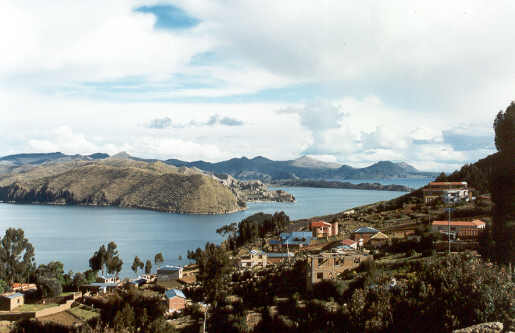26 November 2002: La Paz, Bolivia
Subject: Bolivia
Well we've crossed into Bolivia at last. And Back into Peru. And back into Bolivia again. My passport is going to fill up soon at this rate!
Copacabana and the Isla Del Sol
We fianlly left Puno on a bus bound for Copacabana in Bolivia. The Peru-Bolivia border doesn't go straight down the middle of Lake Titicaca but snags a peninsular on the Peruvian side into Bolivia. Copacabana is the main town on this peninsular, and the Isla Del Sol and the Isla De La Luna are Bolivian islands reached by boat from there.
The border formalities are straightforward and we arrived in Copacabana at lunch time. Copacabana has a famous shrine where bolivians come to have things blessed, like new cars and little model houses. They are quite serious about this: they honestly think that the Virgin of Whatever will intervene and stop them from crashing over a precipice if they have had their vehicle blessed in Copacabana. This makes the town quite a destination for Bolivian day trippers. In an effort to make it less appealing the authorities impose an entrance fee of one Boliviano (about 10p) for everyone entering the town - even bus passengers who are passing through on their way to La Paz! Since they obviously didn't want any more visitors we got straight on a boat over the the Isla Del Sol.
The Isla Del Sol has an important role in the Inca creation legend. I forget the details, but it is something like the birthplace of the four brothers who made their way to Cusco, "navel of the earth". Anyway there are a couple of bits of Inca ruin to look at. But mostly it is just a pleasant sunny island in Lake Titicaca where you can relax for a couple of days, and that's what we did.

Of course it also has something in common with Amantani and Taquile, the two islands in the Peruvian half of the lake that we visited a few days earlier. But Isla Del Sol is quite a bit more developed: they have electricity from the mainland, for example. But what they all share is not looking as if they belong on Lake Titicaca. In the afternoon sun, with donkeys climbing the steep steps up from the port (and ignoring the odd lama in amongsth them), you could be on a Greek island. (Christine and I have both just read books set on Greek islands.) When the clouds come down and the lake looks grey, according to an Irish guy we met it could be the view from his window in Donegal. But one difference from either of those places is the view of 6000m+ snow-capped mountains in the distance.
So after a couple of nights we returned to Copacabana. (And discovered that the cheeky buggers charge only 9 Bs to get out to the island, but getting back costs 15. Arrgghh!) Next stop was to be La Paz, and it should have been a simple bus trip of about three or four hours. But no! Remember that Copacabana is on a Bolivian peninsular on the Peruvian side of the lake? Well to get over to Bolivia proper you have to take a short ferry ride. (And I was quite looking forward to this ferry ride because you get to see the Bolivian Naval Base. Bolivian hasn't had any sea for its navy to patrol since the War of the Pacific.) Anyway it seems that the town where this ferry crossing is located feels that it isn't getting its share of the tourist business from Copacabana, so - believe it or not - they have barracaded the crossing. As if that is going to increase it! So we had to take the long route: back into Peru and right around the bottom of the lake.
The journey was quite an adventure. The first collectivo from Copacabana back to the frontier was relatively unadventurous. Then, rather than a series of three buses to get to the other border crossing, five of us decided to share a taxi. Unfortunately the taxi we chose had a dodgy gearbox and got slower and slower, until we were doing only about 20 kph. At this point the driver gave up and we transfered into another taxi for the last 30 km; this driver decided to do the whole trip at 100 to 130 kph! So we arrived in Desaguadera, did two more lots of border formalities (they were a bit overworked, due to the extra people, but still it was fairly painless), walked across the frontier bridge (it may be the place where the water flows out of Lake Titicaca towards Lake Poopo, from where it evaporates), and got on a bus to La Paz.
La Paz
We've not seen much of La Paz yet, but as you come into the city you get to appreciate its spectacular location. From Titicaca the road crossed a large flat plain, probably former lake bed, at about 3900m. The new outskirts of La Paz, including the airport, are up on this plain. Then suddenly the bus reaches the edge of a cliff and starts to wind down it round a series of hairpin bends (a bit like the train ride into Cusco). The city is spread over the sides and floor of a steep canyon, and to make it even more impressive there is a huge snow-capped mountain as a backdrop.
We have various mundane things to do over the next day or two, and we also have to decide what to do next. A trip to the jungle? To the mountains? To the salt lakes? Stay tuned for the next installment!